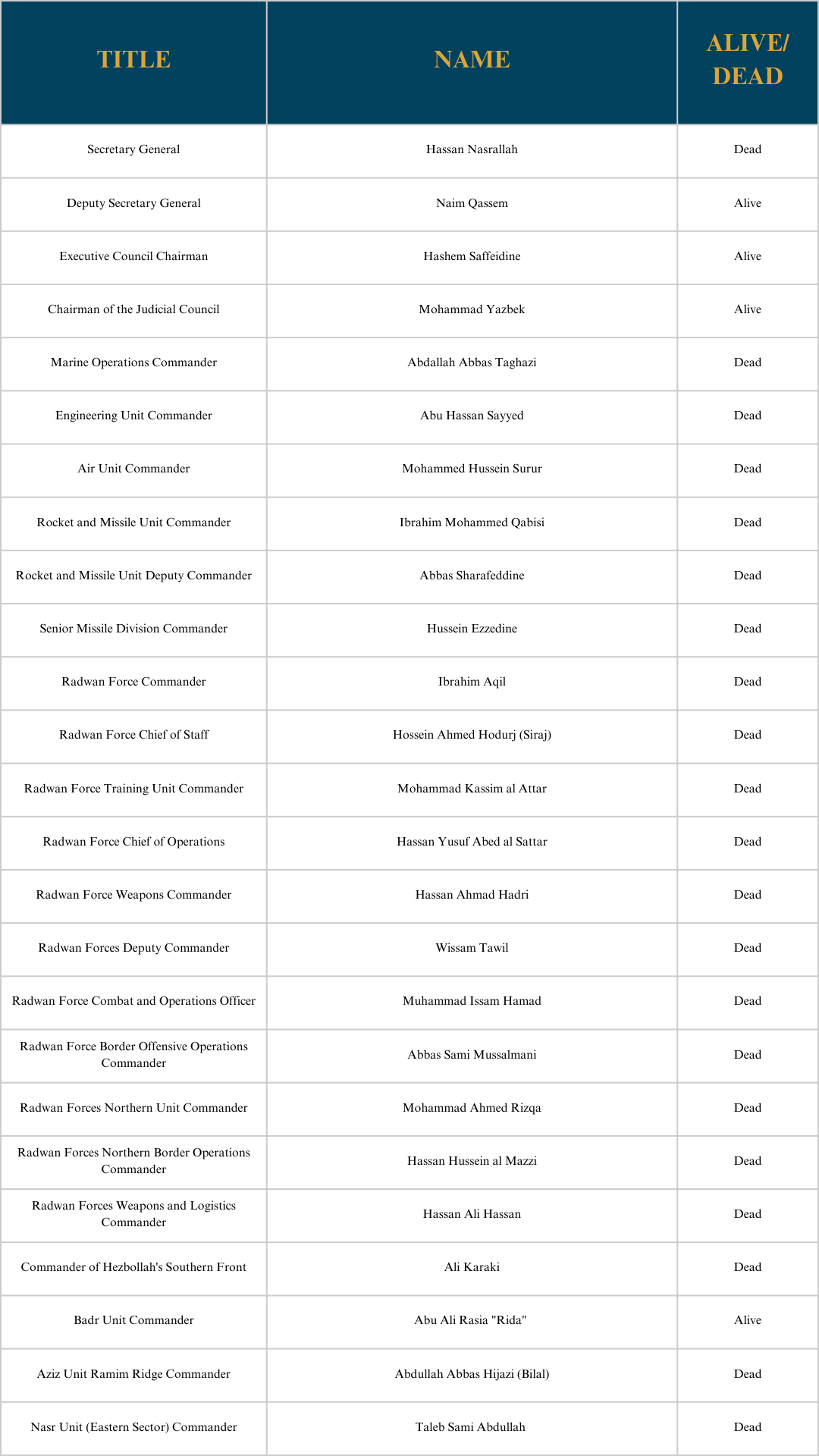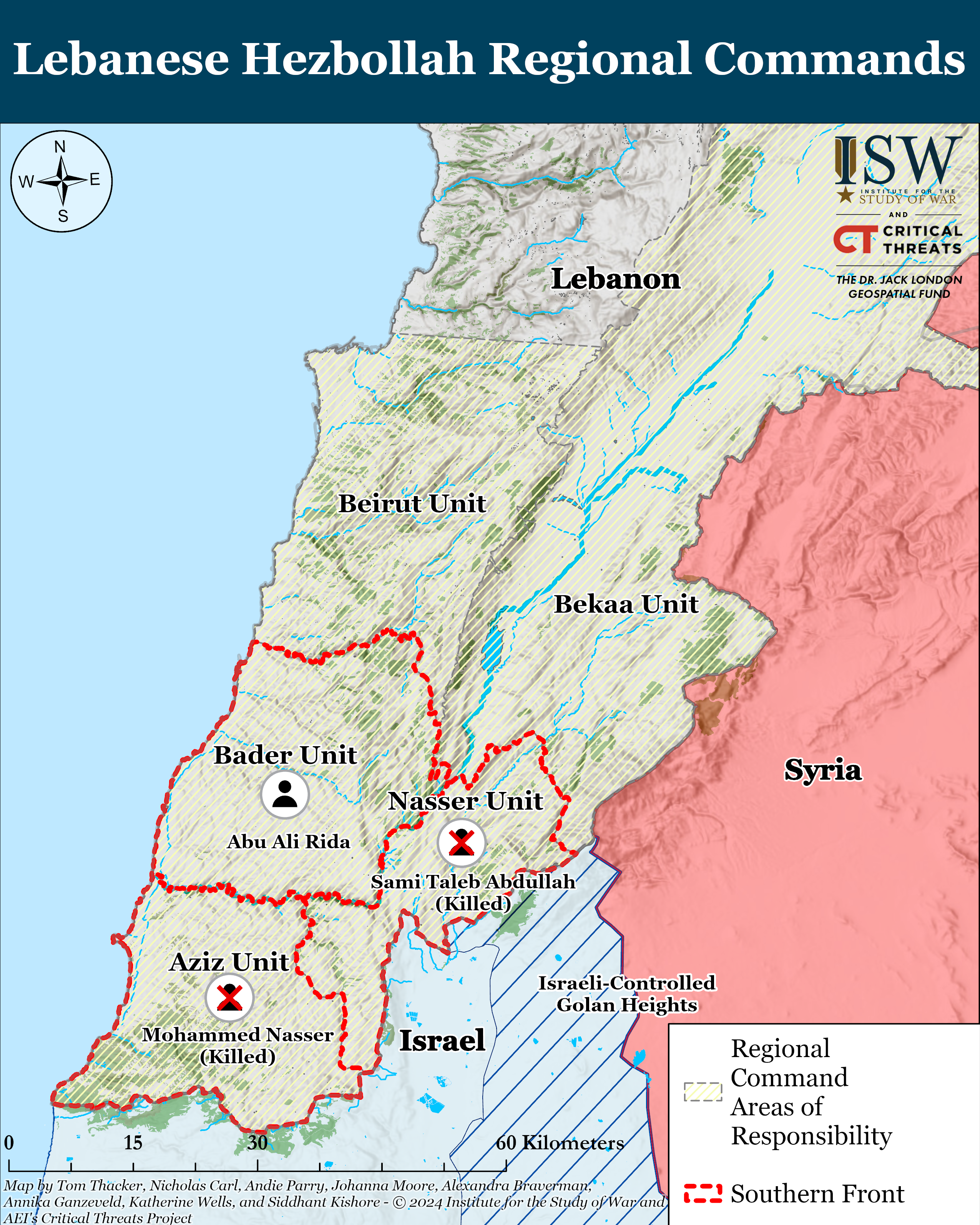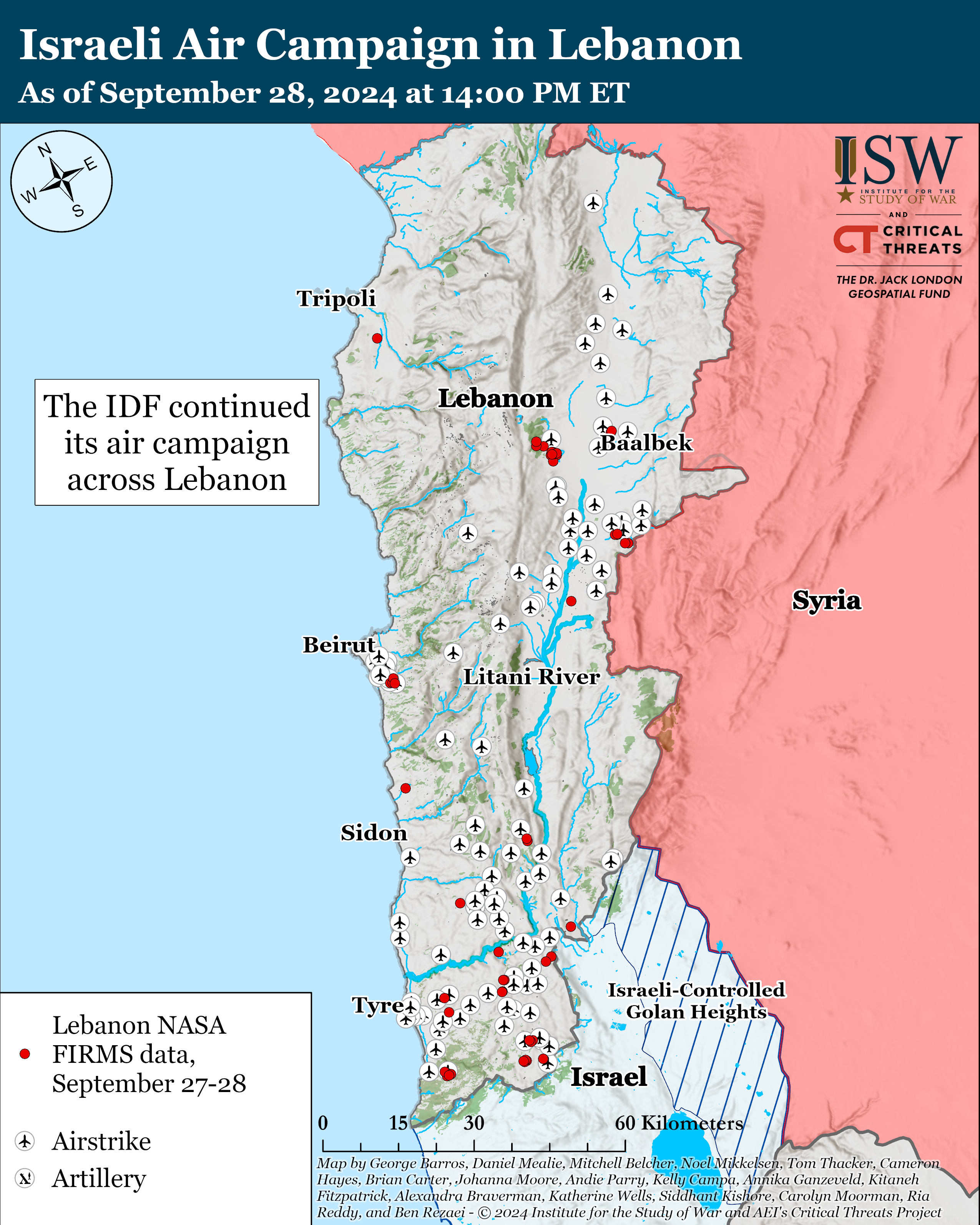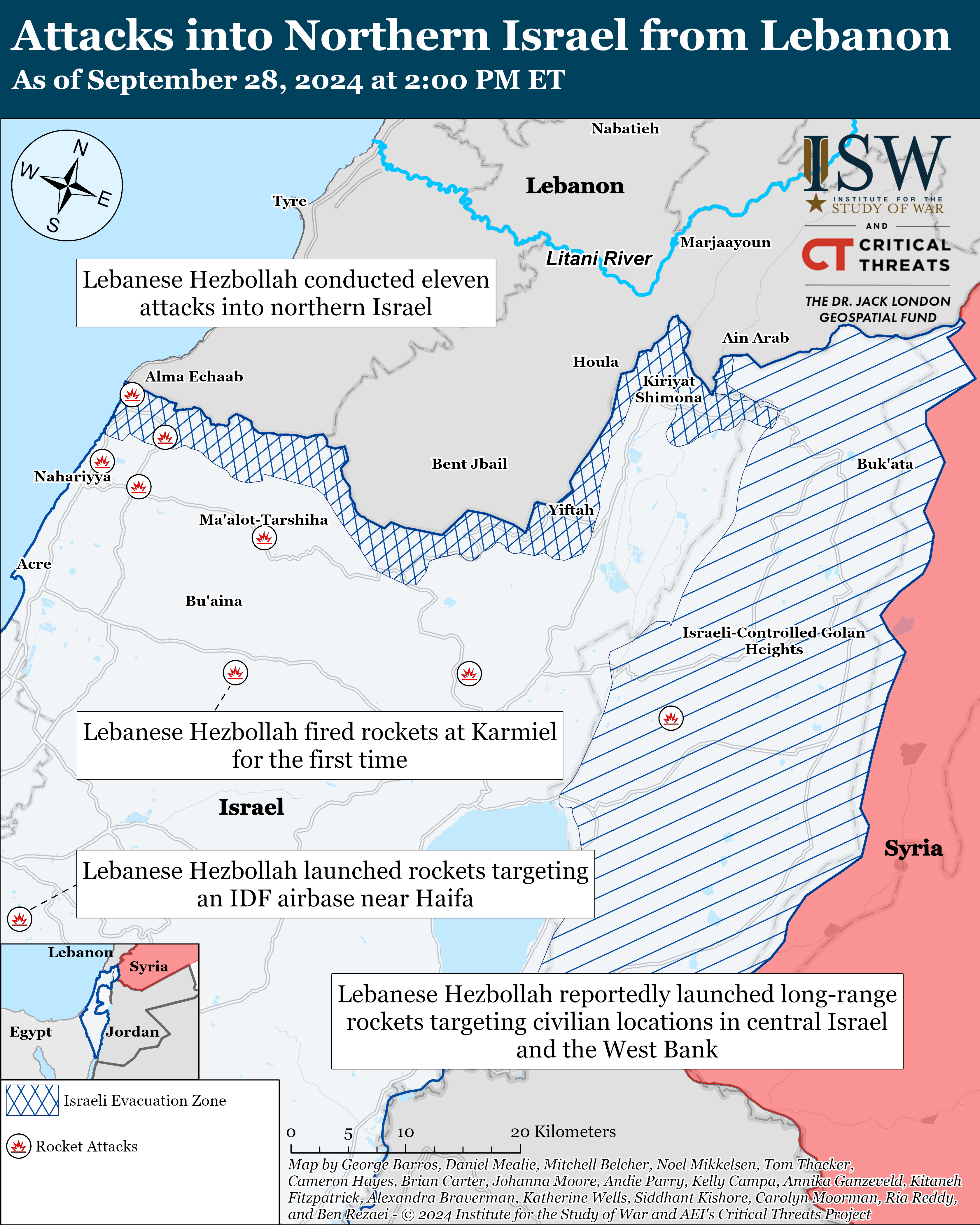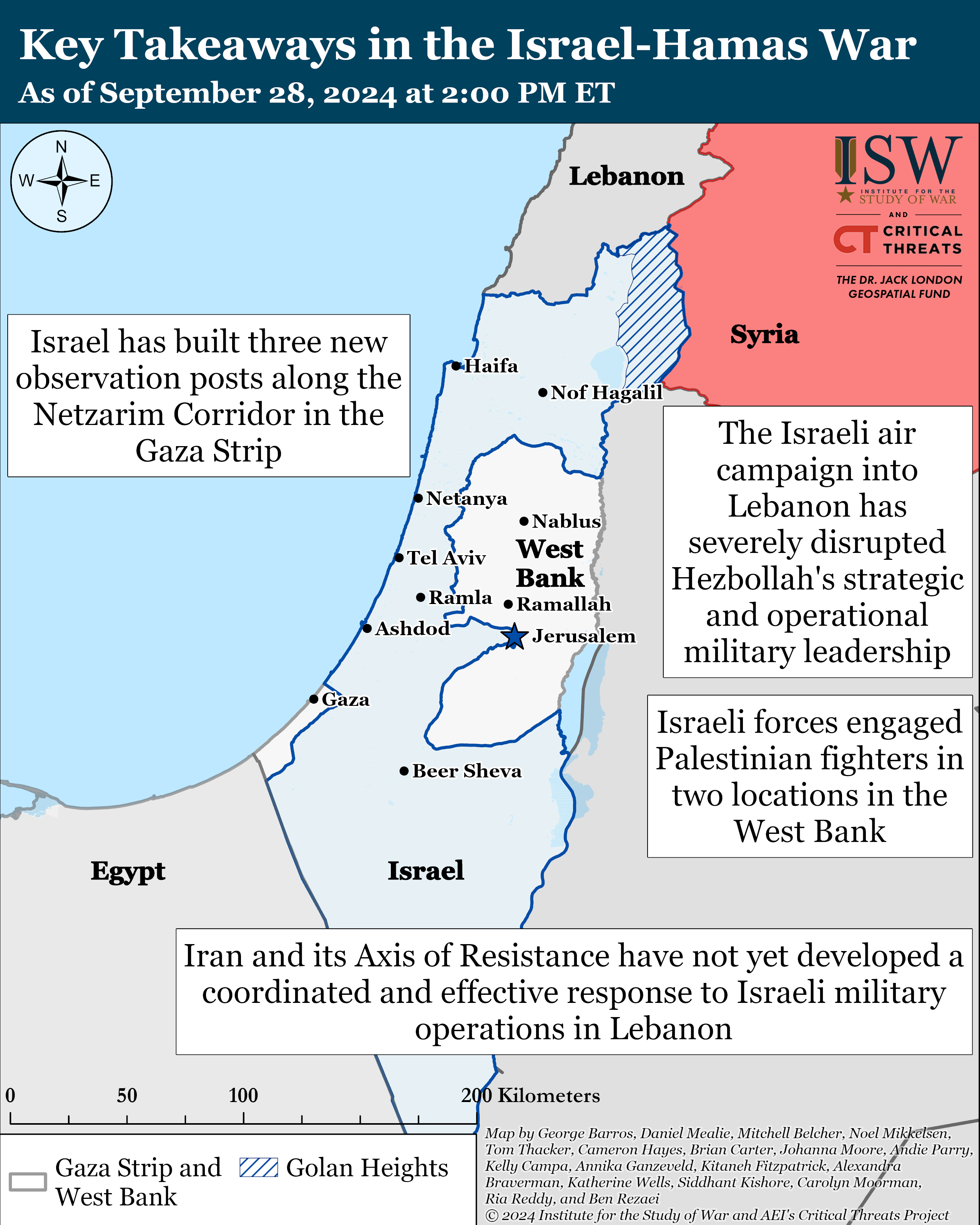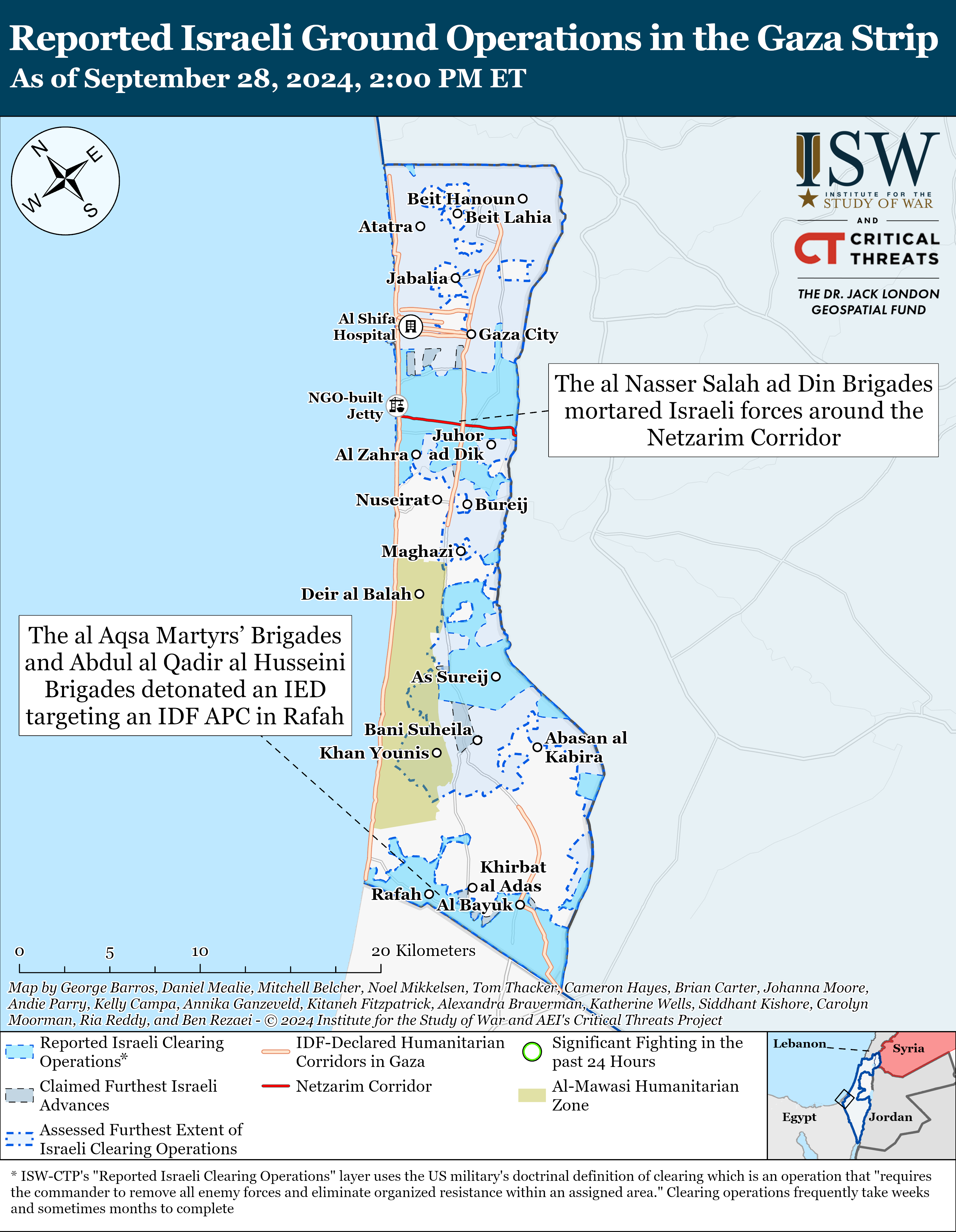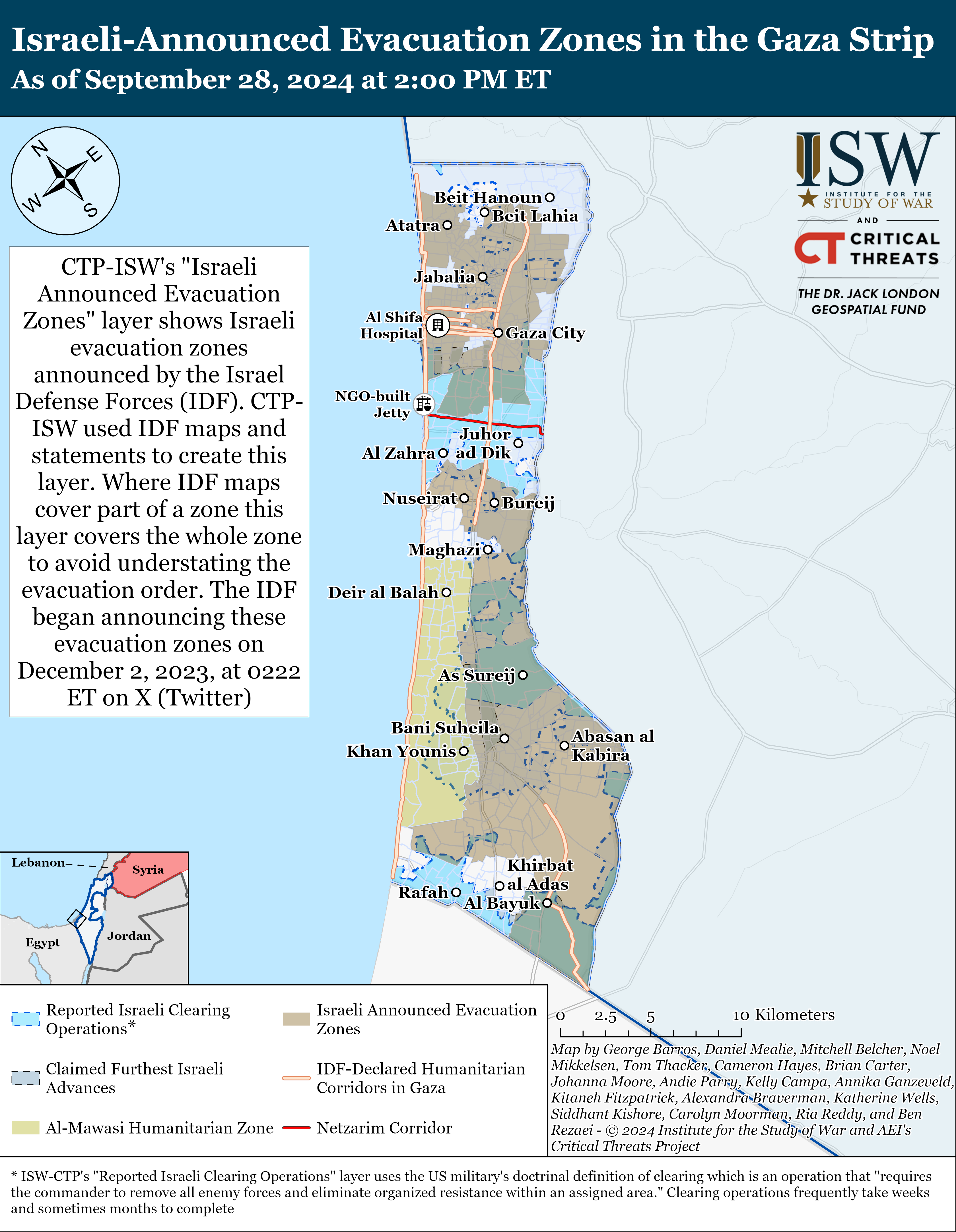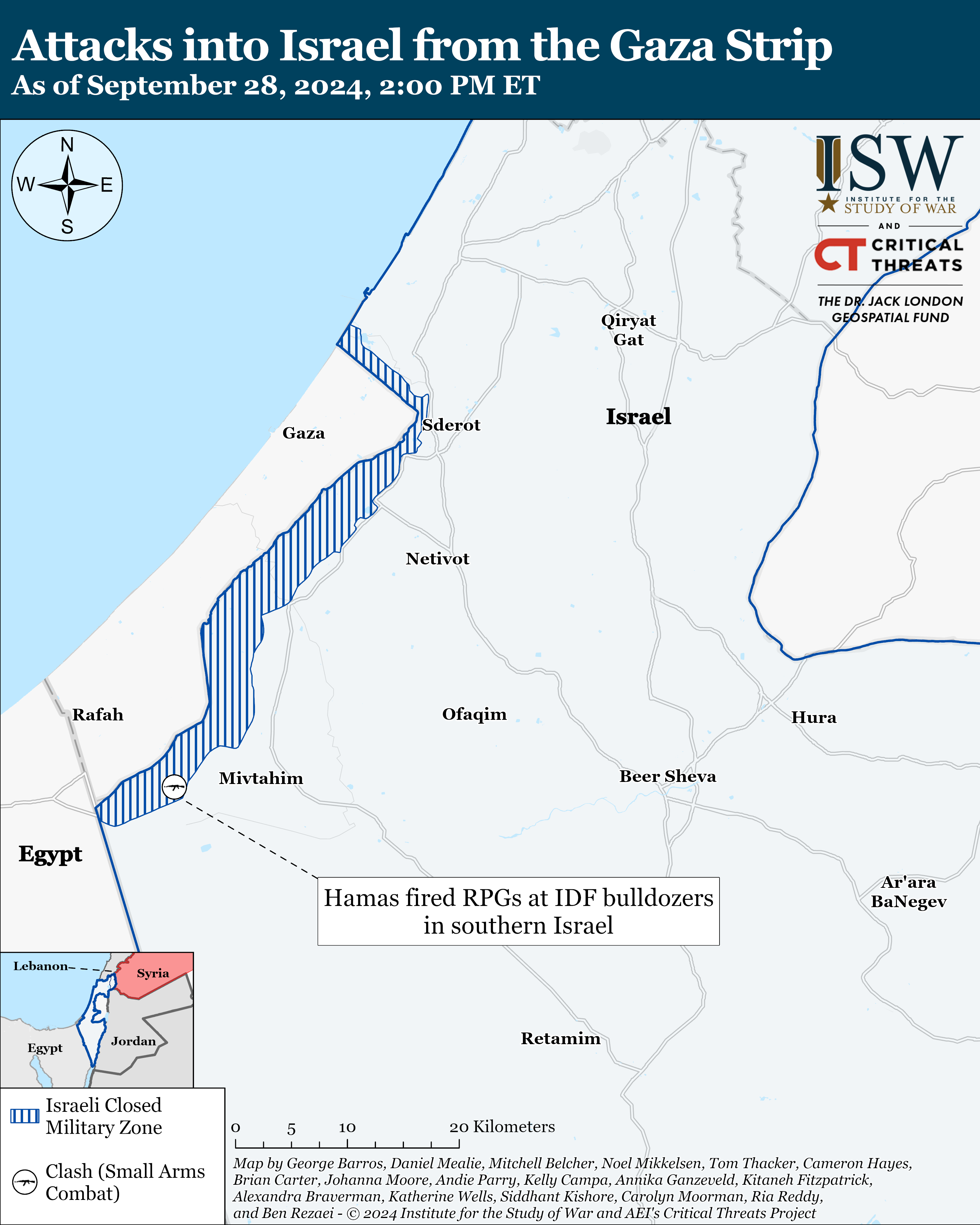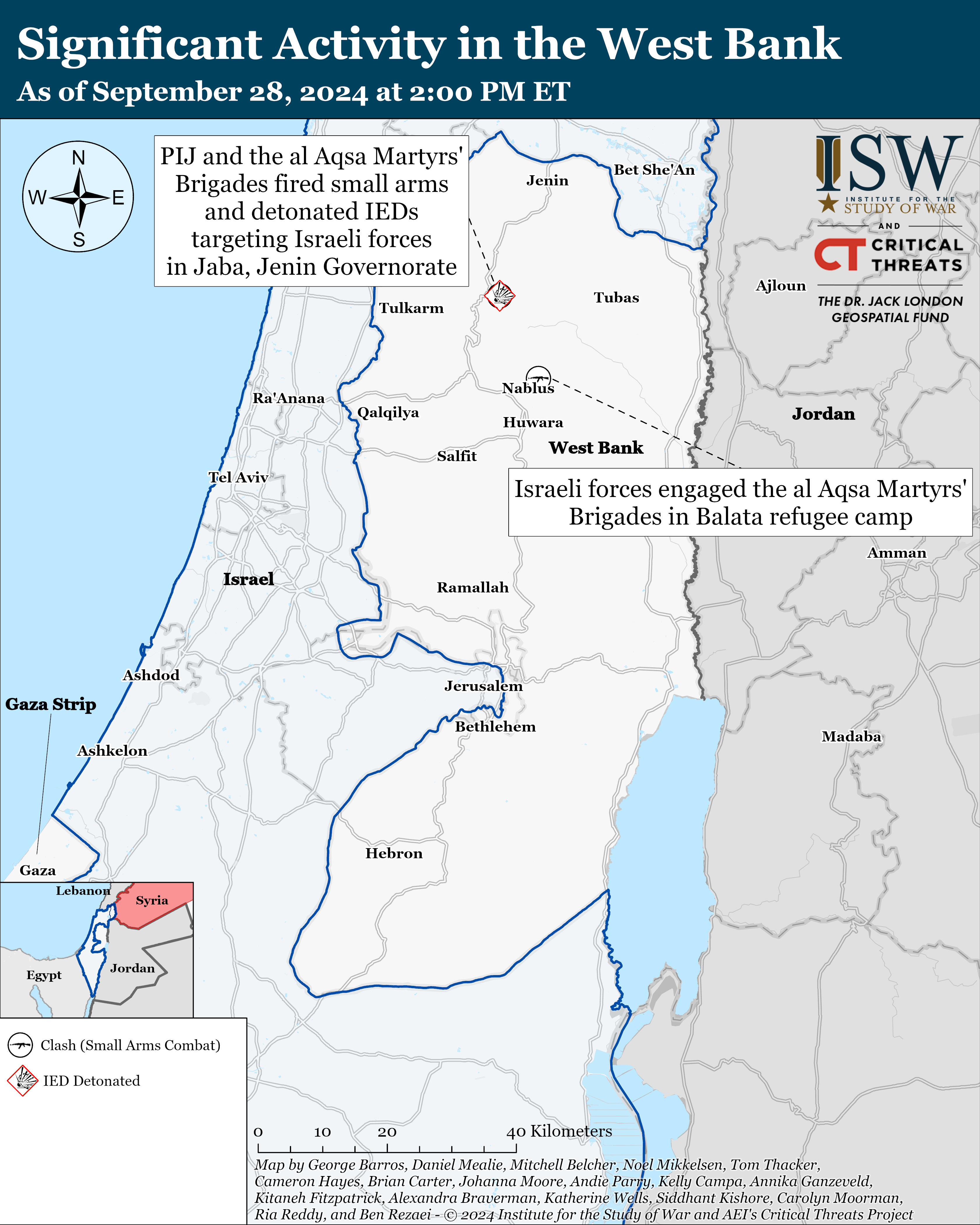 |
 |
Iran Update, September 28, 2024

Iran Update, September 28, 2024
Johanna Moore, Siddhant Kishore, Alexandra Braverman, Katherine Wells, Annika Ganzeveld, and Nicholas Carl
Information Cutoff: 2:00pm ET
The Iran Update provides insights into Iranian and Iranian-sponsored activities abroad that undermine regional stability and threaten US forces and interests. It also covers events and trends that affect the stability and decision-making of the Iranian regime. The Critical Threats Project (CTP) at the American Enterprise Institute and the Institute for the Study of War (ISW) provides these updates regularly based on regional events. Click here to see CTP and ISW’s interactive map of Israeli ground operations. This map is updated daily alongside the static maps present in this report.
CTP-ISW defines the “Axis of Resistance” as the unconventional alliance that Iran has cultivated in the Middle East since the Islamic Republic came to power in 1979. This transnational coalition is comprised of state, semi-state, and non-state actors that cooperate to secure their collective interests. Tehran considers itself to be both part of the alliance and its leader. Iran furnishes these groups with varying levels of financial, military, and political support in exchange for some degree of influence or control over their actions. Some are traditional proxies that are highly responsive to Iranian direction, while others are partners over which Iran exerts more limited influence. Members of the Axis of Resistance are united by their grand strategic objectives, which include eroding and eventually expelling American influence from the Middle East, destroying the Israeli state, or both. Pursuing these objectives and supporting the Axis of Resistance to those ends have become cornerstones of Iranian regional strategy.
We do not report in detail on war crimes because these activities are well-covered in Western media and do not directly affect the military operations we are assessing and forecasting. We utterly condemn violations of the laws of armed conflict and the Geneva Conventions and crimes against humanity even though we do not describe them in these reports.
Lebanese Hezbollah confirmed that Israel killed its secretary general, Hassan Nasrallah, in an airstrike in Beirut on September 27.[1] The Israel Defense Forces (IDF) reported that Israel was aware of Nasrallah’s whereabouts for months and conducted the airstrike to exploit a brief window of opportunity.[2] Unspecified Israeli officials said that Israel dropped over 80 explosive munitions on Hezbollah’s main military headquarters where Nasrallah was located.[3] The IDF confirmed that the commander of Hezbollah’s Southern Front, Ali Karaki, also died in the airstrike.[4] Iranian media confirmed that IRGC Operations Deputy Brigadier General Abbas Nilforoushan died as well.[5] Unspecified Israeli officials suggested that the chairman of Hezbollah’s Executive Council, Hashem Saffiedine, is expected to succeed Nasrallah.[6]
The Israeli air campaign into Lebanon has likely severely disrupted the strategic- and operational-level military leadership in Hezbollah. Continued Israeli airstrikes have killed numerous senior and mid-tier Hezbollah commanders, including Nasrallah, in recent days. These strikes almost certainly worsened the internal disarray that Hezbollah was already facing after Israel detonated thousands of pagers and personal radios belonging to Hezbollah members. Hezbollah appears to be suffering from temporary organizational paralysis, as it has not responded to Israel in any meaningful way and has failed to stop Israel from targeting its key leadership or take necessary steps to protect that leadership. Hezbollah has built a professionalized military force that should be able to overcome this disruption, however, if given the time and space to do so. All the commanders that Israel has killed have deputies who should in principle be able to fill those roles and help the force recover, although they will have taken over under extremely difficult circumstances and under intense pressure.
This chart depicts some of the damage recently done to Hezbollah’s senior ranks. This chart is incomplete and not exhaustive, however. CTP-ISW will build upon this dataset in the coming days and weeks. Sources are available upon request.
The damage to Hezbollah’s operational-level military leadership will impede its ability to conduct and sustain coherent military campaigns at least in the short term. Commanders at this echelon, such as the heads of Hezbollah’s regional units, would be responsible for planning and overseeing campaigns and major operations, including a defense against an Israeli ground offensive into Lebanon.[7] Subordinate units would struggle to coordinate effectively without coherent higher headquarters. Operational-level commanders would also be responsible for coordinating across sectors and managing the intelligent allocation of resources, which would be particularly critical for sustaining campaigns. Tactical-level commanders will likely lack the means to execute an independent military effort that would generate a serious effect without support from operational-level leadership.
The damage Israel has done to Hezbollah's operational-level leadership will likely severely degrade Hezbollah's ability to plan and conduct a large-scale effective drone-missile campaign against Israel in the short term, since such a campaign requires both extensive and detailed planning and a degree of coordination that Israel's disruption of Hezbollah communications likely makes extremely difficult. The disruption caused by Israel's air campaign is a temporary effect, however. Any organized military will reconstitute its leadership and communications abilities if given time and space to do so. The continued and increasing pressure the IDF has applied to Hezbollah has likely prevented the group from reconstituting thus far and may continue to do so if the pressure is sustained.
CTP-ISW is not prepared to assess the combat effectiveness of Hezbollah’s tactical-level units, although they are likely degraded to various degrees. The IDF has conducted airstrikes aimed at these units in southern Lebanon for months in order to “prepare the area for the possibility of [Israeli forces’] entry.”[8] But CTP-ISW has not observed enough data to assess what effects these airstrikes have had at this point. Even isolated tactical units that have survived could likely fight effectively on their own at least for some time against an Israeli ground offensive. The IDF campaign against Hezbollah tactical units has almost certainly degraded at least some of them, however.
This map illustrates individual Israeli air and artillery strikes based on local Lebanese reporting. This map depicts strikes reported from 2:00pm ET on September 27 to 2:00pm ET on September 28. This map is not exhaustive. CTP-ISW cannot independently verify the locations of Israeli strikes.
Hezbollah has continued its attacks targeting civilian and military locations in Israel. Hezbollah fired long-range rockets targeting Tel Aviv and the northern West Bank.[9] The IDF detected five projectiles over the West Bank and intercepted most of them.[10] This incident marks the second time that Hezbollah has tried to fire into the West Bank in recent days. Hezbollah also fired rockets targeting nine civilian locations in northern Israel, including Karmiel, marking the first time that Hezbollah has attacked this location.[11] Hezbollah separately fired rockets targeting Safed in the Upper Galilee.[12] The IDF detected 30 projectiles in the area and intercepted some, while the others fell in open areas around Safed.[13]
Iran and its Axis of Resistance have not yet responded in any coherent or clearly coordinated fashion to the Israeli air campaign into Lebanon. The Iranian Supreme National Security Council (SNSC), which is the seniormost defense and foreign policy body in Iran, held an emergency meeting at the residence of Supreme Leader Ali Khamenei on September 27 to discuss the Israeli strike targeted Hassan Nasrallah.[14] Khamenei typically attends SNSC meetings only during serious crises, such as immediately following Israel killing Ismail Haniyeh in July 2024 and the United States killing Qassem Soleimani in January 2020.[15] The Axis of Resistance has otherwise sustained its regular operations vis-a-vis Israel, which is discussed in further detail below. The Islamic Resistance in Iraq—a coalition of Iranian-backed Iraqi militias—claimed five drone attacks targeting Israel, for instance, which is largely consistent with its usual activity. Iranian-backed Iraqi militias separately issued generic threats toward the United States and Israel in response to the Israeli killing of Nasrallah.
Some Axis of Resistance leaders have increased their personal security measures, which may impede coordination across the alliance. Khamenei moved to a “secure location” in Iran after Israel killed Nasrallah, according to Reuters, citing two unspecified sources in the Middle East.[16] Saudi-owned outlet al Arabiya reported on September 28 that Hamas leader Yahya Sinwar has “ceased his movements” and changed his ”security circle” in response to the killing of Nasrallah.[17] These security measures and others that senior Axis of Resistance officials may be taking will not preclude the Axis of Resistance from coordinating a response to Israel, however. It is furthermore unclear whether the Axis of Resistance yet fully understands the extent to which Israel has disrupted Hezbollah leadership.
The Islamic Resistance in Iraq—a coalition of Iranian-backed Iraqi militias—has claimed five attacks targeting Israeli targets since CTP-ISW's last data cutoff on September 27.[18] The claims include the following:
- A drone attack targeting an unspecified “vital target” in northern Israel[19]
- A drone attack targeting an unspecified “military target” in northern Israel[20]
- A drone attack targeting an unspecified “vital target” in the Golan Heights[21]
- A drone attack targeting an unspecified “vital target” in Tel Aviv[22]
- A drone attack targeting an unspecified “vital target” in southern Israel[23]
Iranian-backed Iraqi militia Kataib Hezbollah blamed “Zionist-American aggression” for Nasrallah’s death in a statement on September 28.[24] Iranian-backed Iraqi militia Kataib Sarkhat al Quds, formerly known as Ashab al Kahf, separately warned on September 28 that “everyone who participated, supported and backed” the IDF airstrike targeting Nasrallah is part of its “upcoming target bank.”[25]
Key Takeaways:
- Lebanon: Lebanese Hezbollah confirmed that Israel killed its secretary general, Hassan Nasrallah, in an airstrike in Beirut. The airstrike also killed several other senior Hezbollah officials and an IRGC brigadier general.
- Lebanon: The Israeli air campaign into Lebanon has likely severely disrupted the strategic- and operational-level military leadership of Hezbollah. This disruption was likely worsened by the internal disarray that Hezbollah already faced after the Israeli pager and radio attack.
- Lebanon: The damage that Israel has done to Hezbollah’s operational-level leadership will likely severely degrade Hezbollah’s ability to conduct a large-scale drone-missile campaign against Israel in the short term.
- Iran: Iran and its Axis of Resistance have not yet responded in any coherent or clearly coordinated fashion to the Israeli air campaign. Axis of Resistance leaders have increased their personal security measures, which may impede coordination.
- Iraq: The Islamic Resistance in Iraq claimed five attacks targeting Israel. Iranian-backed Iraqi militias also issued generic threats toward the United States and Israel in response to Israel killing Hassan Nasrallah.
Gaza Strip
Axis of Resistance objectives:
- Erode the will of the Israeli political establishment and public to sustain clearing operations in the Gaza Strip
- Reestablish Hamas as the governing authority in the Gaza Strip
Commercially available satellite imagery captured on September 27 shows that the IDF has constructed three new observation posts along the Netzarim Corridor in the northern Gaza Strip.
The al Nasser Salah ad Din Brigades—the military wing of the Popular Resistance Committees—mortared Israeli forces along the Netzarim Corridor on September 28.[26]
The IDF continued clearing operations in Rafah in the southern Gaza Strip on September 27. Commercially available satellite imagery captured on September 27 showed the IDF demolished buildings in at least three locations around Rafah. CTP-ISW reported on September 24 that the IDF 162nd Division has been conducting clearing operations in Rafah.[27]
The al Aqsa Martyrs’ Brigades and Abdul al Qadir al Husseini Brigades detonated an improved explosive device (IED) targeting an IDF armored personnel carrier in al Janina, east of Rafah City, on September 28.[28]
Hamas fired rocket-propelled grenades (RPG) targeting an IDF bulldozer in southern Israel on September 27.[29]
West Bank
Axis of Resistance objectives:
- Establish the West Bank as a viable front against Israel
Israeli forces have engaged Palestinian fighters in at least two locations in the West Bank since CTP-ISW's last data cutoff on September 27.[30] Palestinian Islamic Jihad (PIJ) and the al Aqsa Martyrs’ Brigades fired small arms and detonated IEDs targeting Israeli forces in Jaba, Jenin Governorate.[31] The IDF separately engaged the al Aqsa Martyrs’ Brigades in Balata refugee camp, Nablus, on September 27 and 28.[32]
This map is not an exhaustive depiction of clashes and demonstrations in the West Bank.
Southern Lebanon and Golan Heights
Axis of Resistance objectives:
- Deter Israel from conducting a ground operation into Lebanon
- Prepare for an expanded and protracted conflict with Israel in the near term
- Expel the United States from Syria
Lebanese Hezbollah has conducted at least eleven attacks into northern Israel since CTP-ISW's last data cutoff on September 27.[33] See the topline section for more information.

[1] https://t.me/C_Military1/60721 ; https://t.me/mmirleb/7378
[2] https://www.nytimes.com/2024/09/28/world/middleeast/why-israel-assassinate-nasrallah.html
[3] https://www.nytimes.com/2024/09/28/world/middleeast/why-israel-assassinate-nasrallah.html ; https://x.com/GLZRadio/status/1839952102656802852
[4] https://www.washingtonpost.com/world/2024/09/28/israel-lebanon-hezbollah-hamas-war-news-gaza/#link-XAPWWBM4JZAV5DLMHDRMM467T4 ;
[5] https://www.barrons.com/news/senior-iran-guards-general-killed-in-israel-lebanon-strike-state-media-2f5f86b2 ; https://www.wsj.com/world/middle-east/israel-brings-fight-to-beirut-still-assessing-whether-hezbollahsleader-is-dead-1bf0d098?mod=middle-east_news_article_pos1
[6] https://www.nytimes.com/2024/09/28/world/middleeast/why-israel-assassinate-nasrallah.html ; https://x.com/Doron_Kadosh/status/1839968467497132201
[7] https://www.armyupress.army.mil/Journals/Military-Review/English-Edition-Archives/November-December-2021/Harvey-Levels-of-War/
[8] https://t.me/moriahdoron/14401%20;%20https://x.com/idfonline/status/1838950838590386582
[9] https://www.timesofisrael dot com/liveblog_entry/idf-around-90-rockets-fired-at-israel-from-lebanon-throughout-day/
[10] https://x.com/idfonline/status/1839900254453268493
[11] https://t.me/mmirleb/7364 ; https://t.me/mmirleb/7366 ; https://t.me/mmirleb/7368 ; https://t.me/mmirleb/7371 ; https://t.me/mmirleb/7374 ; https://t.me/mmirleb/7375 ; https://t.me/mmirleb/7376 ; https://t.me/mmirleb/7377 ; https://t.me/mmirleb/7379
[12] https://t.me/mmirleb/7364
[13] https://x.com/idfonline/status/1839757771220099145
[14] https://www.nytimes.com/live/2024/09/27/world/israel-lebanon-hezbollah-hamas?smid=url-share#0a4fa027-2fcf-57bb-9b70-1d581d339946
[15] https://www.criticalthreats.org/analysis/iran-update-july-31-2024
[16] https://www.reuters.com/world/middle-east/iranian-leader-khamenei-calls-muslims-confront-israel-2024-09-28/
[17] https://www.alarabiya dot net/arab-and-world/2024/09/28/%D8%AA%D8%AD%D8%B3%D8%A8%D8%A7%D9%8B-%D8%A7%D9%84%D8%B3%D9%86%D9%88%D8%A7%D8%B1-%D9%8A%D8%BA%D9%8A%D8%B1-%D9%85%D9%83%D8%A7%D9%86%D9%87-%D8%AF%D8%A7%D8%AE%D9%84-%D8%BA%D8%B2%D8%A9-%D8%B9%D9%82%D8%A8-%D9%85%D9%82%D8%AA%D9%84-%D9%86%D8%B5%D8%B1%D8%A7%D9%84%D9%84%D9%87
[18] https://t.me/ElamAlmoqawama/1287 ; https://t.me/ElamAlmoqawama/1285 ; https://t.me/ElamAlmoqawama/1283 ; https://t.me/ElamAlmoqawama/1282 ;
[19] https://t.me/ElamAlmoqawama/1283
[20] https://t.me/ElamAlmoqawama/1282
[21] https://t.me/ElamAlmoqawama/1285
[22] https://t.me/ElamAlmoqawama/1287
[23] https://t.me/ElamAlmoqawama/1280
[24] https://t.me/centerkaf/4614
[25] https://t.me/aishab_alkahf/229
[26] https://t.me/alwya2000/6875
[27] https://understandingwar.org/backgrounder/iran-update-september-24-2024
[28] https://t.me/elaqsa_1965/7572
[29] https://alqassam dot ps/arabic/%D8%A8%D9%8A%D8%A7%D9%86%D8%A7%D8%AA-%D8%A8%D9%84%D8%A7%D8%BA%D8%A7%D8%AA-%D8%A7%D9%84%D9%82%D8%B3%D8%A7%D9%85/8117/%D8%A7%D8%B3%D8%AA%D9%87%D8%AF%D8%A7%D9%81-%D8%AC%D8%B1%D8%A7%D9%81%D8%A9-%D8%B9%D8%B3%D9%83%D8%B1%D9%8A%D8%A9-%D9%85%D9%86-%D9%86%D9%88%D8%B9-D9-%D8%A8%D9%82%D8%B0%D9%8A%D9%81%D8%A9-%D8%A7%D9%84%D9%8A%D8%A7%D8%B3%D9%8A%D9%86-105-%D9%81%D9%8A-%D9%85%D9%86%D8%B7%D9%82%D8%A9-%D8%B5%D9%88%D9%81%D8%A7-%D8%B4%D8%B1%D9%82-%D8%AE%D8%A7%D9%86%D9%8A%D9%88%D9%86%D8%B3
[30] https://t.me/elaqsa_1965/7569 ; https://t.me/sarayajneen/1613
[31] https://t.me/sarayajneen/1614 ; https://t.me/elaqsa_1965/7570
[32] https://t.me/elaqsa_1965/7569 ; https://t.me/elaqsa_1965/7569
[33] https://t.me/mmirleb/7364 ; https://t.me/mmirleb/7366 ; https://t.me/mmirleb/7368 ; https://t.me/mmirleb/7371 ; https://t.me/mmirleb/7372 ; https://t.me/mmirleb/7373 ; https://t.me/mmirleb/7374 ; https://t.me/mmirleb/7375 ; https://t.me/mmirleb/7376 ; https://t.me/mmirleb/7377 ; https://t.me/mmirleb/7379
